I ran it for a team of 6, 4 of which were brand new players. It's an excellent adventure for players of all skill levels, and the book does a good job of populating the city with interesting NPC's and factions for them to engage with. The ability to choose the season and the accompanying villain is really interesting, though I ended up using all four in some capacity over the course of the game, with Jarlaxle being the primary antagonist. The party enjoyed him a lot: having to play around a villain that they obviously can't beat in a fight added a good dimension of intrigue to the game, and with one of the players creating a Half-Drow Warlock it was easy to lead in and build intrigue towards the Bregan D'aerth.
If I had to give advice to my past self or another DM planning to run it, I'd note that a lot of the game's encounters can be resolved socially, but the initial adventure hook is clearly built with the expectation of being dealt with through violence, and includes an Intellect Devourer that can easily ruin a low level party's day. However, the opening investigation and search for Floon is relatively well written and has a clean mystery chain of going to a couple different locations, finding clues, and following those clues to the next location, which signposts the rest of the game really well. With that in mind, I wouldn't recommend throwing it out, but I would tweak it so that the Xanathar's Guild and Nihilor can be negotiated with more easily, perhaps even serving as the first source for the main quest and the search for the Stone of Golorr (though obviously many parties/players would chafe at taking orders from or even helping an organization like the Guild). The book also doesn't really have a contingency for the party grabbing the Stone before Act 4, but that shouldn't happen unless you're stupid like me and dangle it in front of their faces, assuming that two level 3 characters won't be able to beat a CR5 monster carrying it (never underestimate players ingenuity, ack).
The only secondary resource I'd recommend for running it if you're looking to get a super deep dive into Waterdeep as a city and its history is the 3.5 City of Splendors sourcebook, which has an obviously outdated historical dive into Waterdeep a century and some before the events of Dragon Heist. Wouldn't call it close to necessary unless you have the unique circumstances I had of 1. A 200 year old player character who was a native of the city and delighted in asking me questions about long winded anecdotes they could tell the party and 2. Planning to continue the game into Dungeon of the Mad Mage, which features many historical mainstays of Waterdeep. Definitely neat though.
